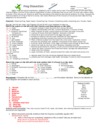
- #Student guide to the frog dissection answer key how to#
- #Student guide to the frog dissection answer key skin#
- #Student guide to the frog dissection answer key free#
Sperm from his testes are released too and the eggs are fertilised outside their bodies. When the male clasps the female during mating (in a position called amplexus), he squeezes her sides to stimulate her to release her eggs into the water. Two small, cream-coloured, bean-shaped testes attached to the top of the kidneys.

The male reproductive system in the frog is quite boring.
#Student guide to the frog dissection answer key skin#
Voilá! Your frog skeleton is complete! Place it on top of the skin layer to continue. Start with the four toes in exactly the same way as the fingers, just make them a bit longer (2 cm worked for us), make bends for the ankle and knee and attach to the pelvis. You'll need the last two pipe cleaners for each of the legs.
#Student guide to the frog dissection answer key free#
Attach the pelvis to the spinal chord in between the vertebrae and the urostyle so that the urostyle is free to do its job as a lever.

The pelvic girdle is even easier: fashion the fourth pipe cleaner into a shield shape based on the template and leave the two ends on either side to attach the legs. Simply attach the third pipe cleaner to the base of the skull, make seven small zig-zags to represent the unfused vertebrae in the spine and the fold and twist the remainder of the pipe cleaner into a rod so that the whole structure is the length of the frog's body. Next up is the spinal chord with the urostyle. You might need to play around with the length of the fingers – slightly less that 1 cm did the trick for us. The shoulder girdle and the arms come next: make a small hand with four fingers at the one end by making three and a half zig-zags, secure by hooking long end of in the pipe cleaner through the first V you made, squeeze together the zig-zags to make the four fingers, make a bend at the elbow, repeat at the other end of the pipe cleaner and attach the central part to the base of the skull. Start with the skull: take the middle of the pipe cleaner as the tip of the nose, make two loops on either side of the nose tip to represent the eye sockets, bend into a u-shape and join together the two ends to make the back of the skull. It might seem a bit daunting, but just follow the steps below, have a look at the pictures and use your own creative sense, and you'll be fine. We recommend that you use one pipe cleaner for each of these sections. If you look carefully at the template, you'll see that the skeleton consists of different shades of grey, dividing it into six sections. We're going to use the pipe cleaners to make a simplified model of the skeleton. They also protect vital organs (like the brain) from mechanical shock, make blood cells and store special minerals. The bones in the body are not only there to support the muscles when the frog is moving about. The frog skeleton also contains a lot more cartilage than yours to make it lighter.

The bones of the second half of the spinal chord are fused together to form a rod (called the urostyle) between the sitting bones that propel the frog into the air. We added some fun facts and useful links for the curious.īy just looking at a frog's skeleton, you can already guess what is its favourite way of moving around – jumping! Powerful hind legs dominate the skeleton.
#Student guide to the frog dissection answer key how to#
It is our hope that teachers and pupils alike will be inspired by this Instructable on how to make your own ready-to-dissect frog. She would have loved to give her students more practical experience with animals, but ethical considerations and limited resources make it impossible for her to expose her students to anything more hands on than a YouTube video.Īs an engineer, an occupational therapist and a zoologist, we immediately put our heads together to design the perfect solution – an educational tool that would allow anyone to perform a virtual dissection of a frog! And the best part? It can all be done with bits and bobs lying around the house, with no background knowledge of frog anatomy whatsoever. However gross it might seem, this frog dissection is the starting point for understanding how our bodies work.Ī friend of ours, a high school biology teacher in a small rural town in South Africa, recently lamented the fact that this iconic activity is no longer part of the school curriculum. What is one of the first things that come to mind when you think of a biology classroom? To some, it might be the dreaded frog dissection, a rite of passage for students of the life sciences the world over.


 0 kommentar(er)
0 kommentar(er)
